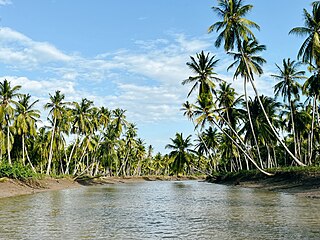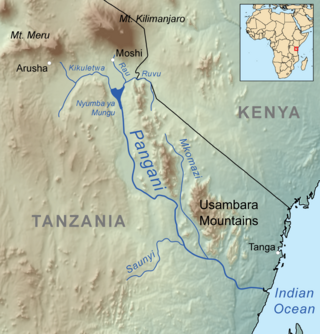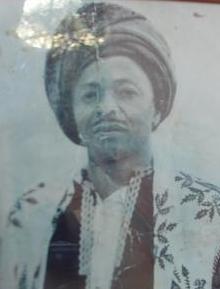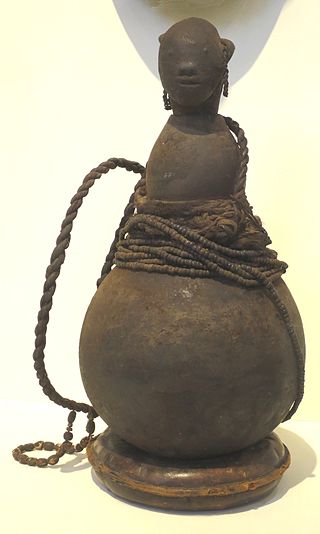
The Chagga are a Bantu ethnic group from Kilimanjaro Region of Tanzania. They are the third-largest ethnic group in Tanzania. They historically lived in sovereign Chagga states on the slopes of Mount Kilimanjaro in both Kilimanjaro Region and eastern Arusha Region.

The Abushiri revolt, also known as the slave trader revolt, was an insurrection in 1888–1889 by the Arab and Swahili population of the areas of the coast of East Africa that were granted, under protest, to Germany by the Sultan of Zanzibar in 1888. It was eventually suppressed by a German expeditionary corps which conquered the coastal area.

Pangani District Council is one of eleven administrative districts of Tanga Region in Tanzania. The District covers an area of 1,756 km2 (678 sq mi). It is bordered to the north by Muheza District, to the east by Zanzibar Channel, to the south by the Chalinze District of Pwani Region, and to the west by the Handeni District. The district is comparable in size to the land area of Guadeloupe. The district seat (capital) and largest settlement in Pangani district is the town of Pangani. The district is named after the historic Pangani River. As of the 2012 census, the population was Pangani district was 54,025, making it the least populous district in Tanga Region.
The Zaramo people, also referred to as Dzalamo or Saramo, are a Bantu ethnic group native to the central eastern coast of Tanzania, particularly Dar es Salaam Region and Pwani Region. They are the largest ethnic group in and around Dar es Salaam, the former capital of Tanzania and the 7th largest city in Africa. Estimated to be about 0.7 million people, over 98% of them are Muslims, more specifically the Shafi'i school of Sunni Islam. Zaramo people are considered influential in Tanzania popular culture with musical genres like Sengeli originating from their commonity in Kinondoni District. Their culture and history have been shaped by their dwelling in both urban and rural landscapes.

Tanga Region is one of Tanzania's 31 administrative regions. The region covers an area of 26,667 km2 (10,296 sq mi). The region is comparable in size to the combined land area of the nation state of Burundi. The regional capital is the municipality of Tanga city. Located in northeast Tanzania, the region is bordered by Kenya and Kilimanjaro Region to the north; Manyara Region to the west; and Morogoro and Pwani Regions to the south. It has a coastline to the east with the Indian Ocean. According to the 2012 national census, the region had a population of 2,045,205.

Muheza District, officially the, Muheza District Council is one of eleven administrative districts of Tanga Region in Tanzania. The District covers an area of 1,498 km2 (578 sq mi). It is bordered to the north by Mkinga District, to the east by Tanga and the Indian Ocean, to the south by the Pangani District and Handeni District, and to the west by the Korogwe District. The district is comparable in size to the land area of Guadeloupe. The town of Muheza, after which the district is named, serves as its administrative capital. According to the 2012 Tanzania National Census, the population of Muheza District had decreased to 204,461; this is less than ten years before, because Mkinga District was created that same year. The highest point in Muheza District is Kimbo Peak at 1,063m.

The Usambara Mountains of northeastern Tanzania in tropical East Africa, comprise the easternmost ranges of the Eastern Arc Mountains. The ranges of approximately 90 kilometres (56 mi) long and about half that wide, are situated in the Lushoto District of the Tanga Region. They were formed nearly two million years ago by faulting and uplifting, and are composed of Precambrian metamorphic rocks. They are split into two sub-ranges; the West Usambaras being higher than the East Usambaras, which are nearer the coast and receive more rainfall.
The Zigua or in some sources Zigula are a Bantu ethnic and linguistic people hailing from far northern Pwani Region and western southern Tanga Region. In Tanga Region they are the majority in Handeni District, northern Kilindi District and also a historically significant population in south of the Pangani River in Pangani District. They speak the Zigula language. In 1993, the Zigua population was estimated to number 355,000 people, today they number 631,000 people.

The Shambaa people, also called the Sambaa, Shambala, Sambala or Sambara, are a Bantu ethnic group. Their ancestral home is on the Usambara Mountains of Lushoto District, Korogwe District and Bumbuli District. They are native to the valleys and eastern Usambara Mountains of Korogwe District, Korogwe Urban District and western Muheza District of northern Tanga Region of Tanzania. The word Shamba means "farm", and these people live in one of the most fertile Tanzanian region. Shambaai in Kisambaa means "where the banana's thrive". In 2001, the Shambaa population was estimated to number 664,000.

The Arusha people are a Bantu ethnic and indigenous group based in the western slopes of mount Meru in Arusha District of Arusha Region in Tanzania. The Maasai regard the Arusha people as related as they were once a part of the immigrant Maasai whom arrived in Arusha in the late 18th century from Kenya. The Arusha people are not to be confused by Arusha residents who are a mix of people of different ethnic backgrounds that are born and reside within the borders of the Arusha Region.
The Shirazi people, also known as Mbwera, are a Bantu ethnic group inhabiting the Swahili coast and the nearby Indian ocean islands. They are particularly concentrated on the islands of Zanzibar, Pemba and Comoros.
Mbegha, also known as Simbe Mwene,, was the first king also known the "Lion King" of the Shambaa people, in modern-day western Tanga Region of Tanzania. King Mbugha lived during the first half of the 18th century. While his existence is undisputed among historians, his biography is mainly based on oral traditions. Numerous legends have made him a mythic hero.

Kimweri ya Nyumbai or Shekulwavu Kimweri ya Nyumabi, also known as, , was the King of the Shambaa people of the Usambara Mountains in what is now Tanga Region of Tanzania between around 1815 and 1862. Under his rule the kingdom reached its greatest extent. However, disruptions caused by the introduction of firearms and the slave trade caused the kingdom to fall apart after his death.

Kimweri Mpuata Magogo or Mputa II, also known as, , was the last king of the Shambaa people of the Usambara Mountains in what is now Tanga Region of Tanzania between around 1947 and 1962. He was the last of the Kilindi dynasty to be recognized as having authority, which was removed in 1962 after Tanzanian independence.
Karagwe Kingdom was a historical Bantu state in present-day Karagwe District of Kagera Region in northwestern Tanzania, between Rwanda and Lake Victoria. East Africa's influential Karagwe Kingdom was ruled by a hereditary monarchs whom were reputed to be Bachwezi descendants. By the end of the 20th century, it had thriving trade with traders from all parts of East Africa, especially slave trading Arabs. Bweranyange served as the Karagwe kingdom's capital.
Erasto Andrew Mbwana Mang'enya was a Tanganyikan/Tanzanian diplomat and politician.
The Kilindi dynasty(c. 1790s – 1862),, is a pre-colonial, Tanzanian royal family that has reigned over the Shambaa people of north-west Tanga Region for most of the 18th to 20th centuries In modern-day Lushoto District and Bumbuli District.
Vugha or Vuga is historic village located inside Bumbuli District of Tanga Region in Tanzania. The settlement was established as the capital of the Kilindi dynasty.

The Mbugu people, also known as the Va'maa, Ma'a are an ethnic Bantu and linguistic group hailing from western Usambara Mountains of Lushoto District in Tanga Region of Tanzania. Tanzania's Mbugu language is one of the few true hybrid languages, combining Bantu grammar with Cushitic lexicon. In actuality, the people speak two languages: one mixed and the other Pare, which is closely linked to the Bantu language. They are estimated to be around 60,000 Mbugu people left.
Magila is an administrative ward in Muheza District of Tanga Region in Tanzania. Magoroto and Kicheba wards form the northern boundary of the ward. The Tanganyika ward is to the east. Kwemkabala, Mbaramo, and Tingeni are to the south. The ward covers an area of 25.4 km2 (9.8 sq mi), According to the 2012 census, the ward has a total population of 6,758.










